We spent two days in Fes (or Fez). While there we toured the ancient medina and also had many "opportunities" to shop and spend money – lots of money – on various local wares. Not being big shoppers, Jim & I escaped with only a couple of djellabas, which we have actually enjoyed wearing from time to time over the years since. Were I to do it over again, I'd like to have gotten a tagine, although how I could have gotten it home is a question.
One notable and unexpected happening during our stay in Fes was a earthquake. Having lived in California for a time, we were awakened by the tremblor, looked at each other, briefly speculated at the magnitude, and went back to sleep. Many of our group flew into the hotel corridors and stayed awake the rest of the night. The quake killed many people and devastated villages in the mountains of northern Morocco.
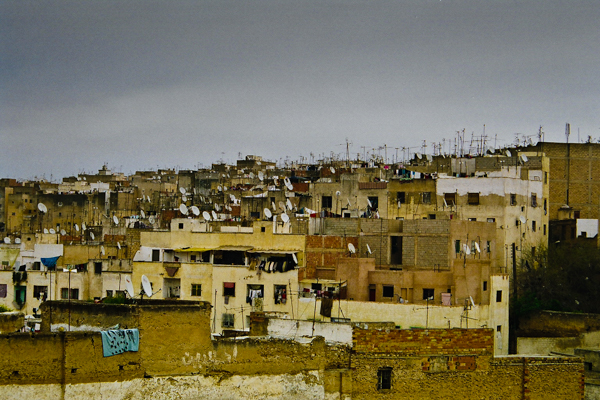
The ancient medina or old quarter of Fes is also on the World Heritage List. Some of these buildings date back hundreds of years, but are festooned with modern satellite dishes and television antennae.
We visited a couple of these town houses. Plain, even shabby, exteriors conceal fabulous gardens and structures with elaborate architectural detail. Unfortunately the Alhambra had overwhelmed me with fabulous gardens and elaborate detail.
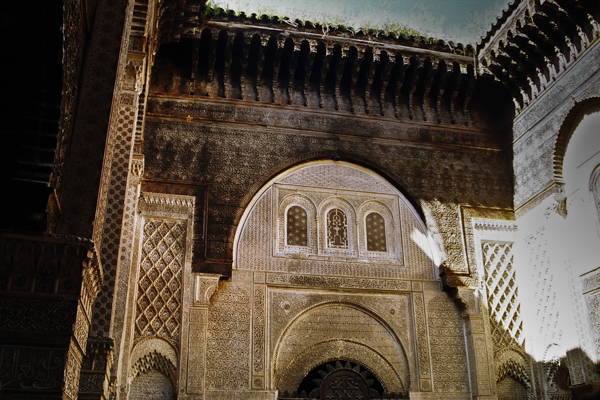 The
only picture I took that begins to capture the detail is of the interior
courtyard of the Madrasa (or Medersa)
Bou
Inania.
The
only picture I took that begins to capture the detail is of the interior
courtyard of the Madrasa (or Medersa)
Bou
Inania.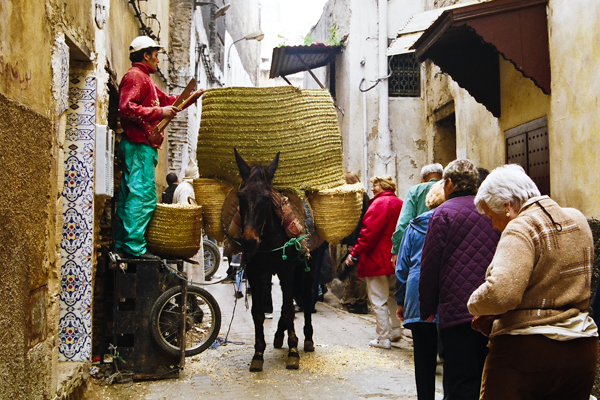 The
narrow streets of the medina are ill suited to cars or trucks. Deliveries
are done via what Ismail called "medina taxis" or mules. When
we saw one of these coming, we had to make way.
The
narrow streets of the medina are ill suited to cars or trucks. Deliveries
are done via what Ismail called "medina taxis" or mules. When
we saw one of these coming, we had to make way.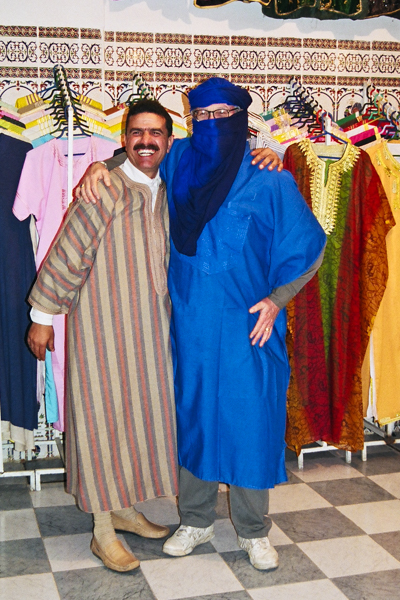 Did I mention shopping opportunities? Ismail is trying to convince
Ray that he should buy a traditional blue djellaba and
turban associated with the
Tuareg people. He didn't.
Did I mention shopping opportunities? Ismail is trying to convince
Ray that he should buy a traditional blue djellaba and
turban associated with the
Tuareg people. He didn't.I had hoped to find some North African tack for my Arabian horse, but I was unsuccessful. I had taken pictures of what I wanted, but was told that it was a Tunisian style. The Moroccan styles that I found did not suit me, so I came home empty-handed.
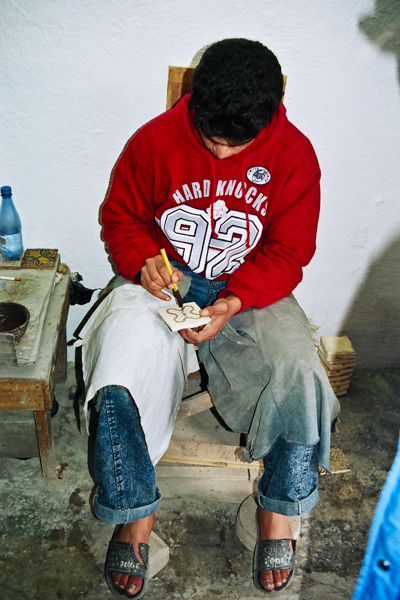
Another craft shop sold everything you can imagine made of tile. It isn't easy to transport, so I don't think anyone fell prey to these offerings, but it was fascinating to watch the workers.
This youngster is painting, freehand, intricate designs on a single tile – he is just beginning the tile he is holding.
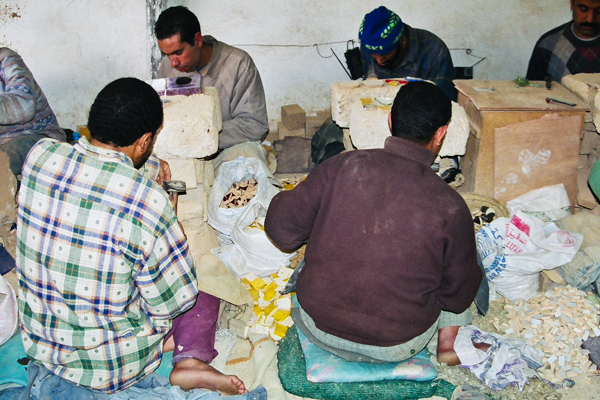
Men putting in the mosaic patterns
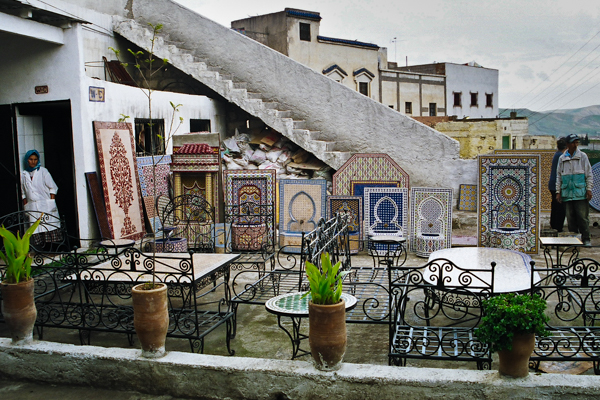
Some finished products.
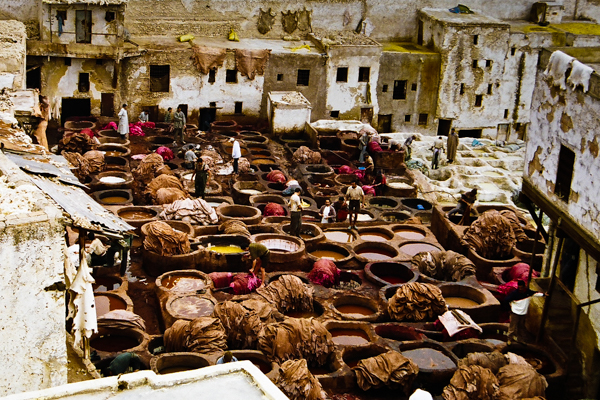 Another
place we visited sold leather, but the interesting part was the manufactory
out back where the leather was dyed. It's hard to see in this picture,
but the vats are full of every color in the rainbow. Gordon, one of
our fellow travelers, was an accomplished photographer and showed me
the difference a polarized filter made in photographing the colors. Since
then I've purchased such a filter, but have never had the opportunity
to use it (except when I didn't have it handy)!
Another
place we visited sold leather, but the interesting part was the manufactory
out back where the leather was dyed. It's hard to see in this picture,
but the vats are full of every color in the rainbow. Gordon, one of
our fellow travelers, was an accomplished photographer and showed me
the difference a polarized filter made in photographing the colors. Since
then I've purchased such a filter, but have never had the opportunity
to use it (except when I didn't have it handy)!
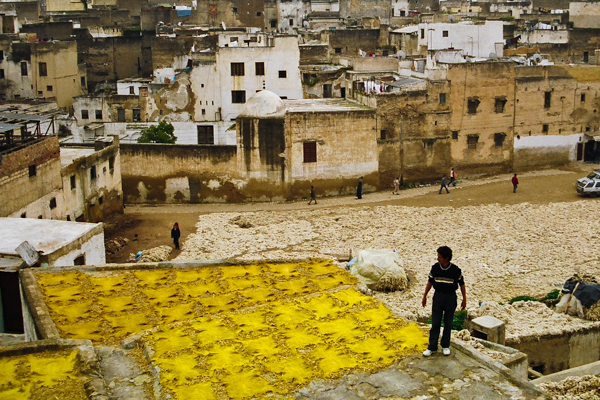 The dyed skins dry on the rooftops. The white substance all around is
wool removed from the goat or sheep skins used in dying. It is used primarily for stuffing.
The dyed skins dry on the rooftops. The white substance all around is
wool removed from the goat or sheep skins used in dying. It is used primarily for stuffing.
Click your "back" button to return to the previous page or click for our picture album.